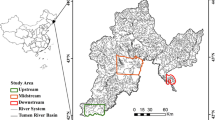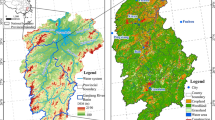Abstract
Based on the Landsat TM data in 1988 and 2002, the GIS technique and Fragstats software were used to calculate the land use conversion matrix and eight landscape metrics at landscape and patch class levels in upstream, midstream, and downstream regions of Nenjiang River basin. The characteristics of land use and landscape pattern changes in each region during 1988–2002 were analyzed. The results show the followings: 1) During the period from 1988 to 2002, farmland and construction land area increased, while the areas of forestland, grassland, and unutilized land decreased in all three regions. The conversion trends from forestland and grassland to farmland were obvious. The conversion from forestland to farmland mainly occurred in the upstream region, whereas the conversion from grassland to farmland primarily occurred in the midstream and downstream regions. 2) The water area in the upstream and midstream regions enlarged, mainly due to the increase of water impounded area as a result of the construction of reservoirs. Comparatively, the water area in the downstream region decreased, and it mainly occurred in the east part of downstream region with concentrated lakes and swamps. 3) The degree of landscape fragmentation increased in each region. The controlling ability of forestland was weakened, and its patch shape became more complicated. In contrast, the controlling ability of farmland was reinforced, and the connectivity among patches increased. 4) The landscape pattern shows some gradient features. From the upstream to downstream regions, the disturbance of human activities on dominant patches was intensified, and consequently, the landscape fragmentation extent and heterogeneity were enhanced.
Similar content being viewed by others
References
Abdullah S A, Nakagoshi N (2008). Changes in agricultural landscape pattern and its spatial relationship with forestland in the state of Selangor, Peninsular Malaysia. Landscape and Urban Planning, 87(2): 147–155
Herzog F, Lausch A, Müller E, Thulke H, Steinhardt U, Lehmann S (2001). Landscape metrics for assessment of landscape destruction and rehabilitation. Environmental Management, 27(1): 91–107
Li X B (1996). A review of the international researches on land use/land cover change. Acta Geographica Sinica, 51(6): 553–558 (in Chinese)
Li G Y, Dong Y W, Liu X M, Zhu H Y, Wang W X (2008). Dynamic change of land use and landscape response in the watershed of Tianmu Lake. Journal of Soil andWater Conversion, 22(1): 180–184 (in Chinese)
Mcgarigal K, Marks B J (1994). Fragstats: spatial pattern analysis program for quantifying landscape structure. Reference manual. Corvallis Oregon: Forest Science Department, Oregon State University
Pan D, Domon G, Blois de S, Bouchard A (1999). Temporal (1958–1993) and spatial patterns of land use changes in haut-saint-Laurent (Quebec, Canada) and their relation to landscape physical attributes. Landscape Ecology, 14(1): 35–52
Pan J H, Liu J L (2005). Land use and its impact in the eco-environment on the Yellow River source region during the past 15 years. Journal of Arid Land Resources and Environment, 19(4): 69–74 (in Chinese)
Sun H, Li Y M, Wang X Z, Ni S X (2003). Method and application of landscape ecological evaluation in the typical small watershed’s land use. Geomatics and Information Science of Wuhan University, 28(2): 177–181 (in Chinese)
Wan R R, Yang G S (2005). Changes of land use and landscape pattern in Taihu Lake Basin. Journal of Applied Ecology, 16(3): 475–480 (in Chinese)
Wang X L, Bao Y H (1999). Study on the methods of land use dynamic change research. Progress in Geography, 18(1): 82–87 (in Chinese)
Wu J G (2000). Landscape Ecology-pattern, Process, Scale and Ranks. Beijing: Higher Education Press (in Chinese)
Wu X, Shen Z Y (2007). Analysis of the changes of land use/cover and landscape pattern in the upper reaches of the Yangtze River. Transactions of the CSAE, 23(10): 86–92 (in Chinese)
Xia B C, Hu J M, Song X S (2004). Analysis of land-use change in Taoerhe Catchment during last 15 years. Journal of Soil and Water Conversion, 18(2): 122–125 (in Chinese)
Ye B Y, Huang F, Liu X N, Zhang S W. Zhang Y Z (2002). The driving forces of land use/cover change in the upstream area of the Nenjiang River. Journal of Northeast Normal University, 34(1): 100–104 (in Chinese)
Zhao Y, Li Y H (2001). Landscape Ecology. Beijing: Science Press (in Chinese)
Zhou H R (2007). Landscape Ecology of Rivers and Corridors in Arid Area. Beijing: Science Press (in Chinese)
Zhu H Y, Li X B (2003). Discussion on the index method of regional land use change. Acta Geographica Sinica, 58(5): 643–650 (in Chinese)
Author information
Authors and Affiliations
Corresponding author
Rights and permissions
About this article
Cite this article
Wang, S., Zhao, Y., Yin, X. et al. Land use and landscape pattern changes in Nenjiang River basin during 1988–2002. Front. Earth Sci. China 4, 33–41 (2010). https://doi.org/10.1007/s11707-010-0006-8
Received:
Accepted:
Published:
Issue Date:
DOI: https://doi.org/10.1007/s11707-010-0006-8




